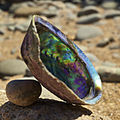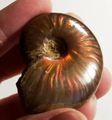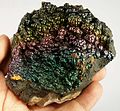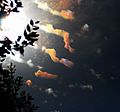Etymology
The word iridescence is derived in part from the Greek word ἶρις îris (gen. ἴριδος íridos), meaning rainbow, and is combined with the Latin suffix -escent, meaning "having a tendency toward". Iris in turn derives from the goddess Iris of Greek mythology, who is the personification of the rainbow and acted as a messenger of the gods. Goniochromism is derived from the Greek words gonia, meaning "angle", and chroma, meaning "colour".
Mechanisms
Iridescence is an optical phenomenon of surfaces in which hue changes with the angle of observation and the angle of illumination. It is often caused by multiple reflections from two or more semi-transparent surfaces in which phase shift and interference of the reflections modulates the incidental light (by amplifying or attenuating some frequencies more than others). The thickness of the layers of the material determines the interference pattern. Iridescence can for example be due to thin-film interference, the functional analogue of selective wavelength attenuation as seen with the Fabry–Pérot interferometer, and can be seen in oil films on water and soap bubbles. Iridescence is also found in plants, animals and many other items. The range of colours of natural iridescent objects can be narrow, for example shifting between two or three colours as the viewing angle changes, or a wide range of colours can be observed.
In biological (and biomimetic) uses, colours produced other than with pigments or dyes are called structural coloration. Microstructures, often multilayered, are used to produce bright but sometimes non-iridescent colours: quite elaborate arrangements are needed to avoid reflecting different colours in different directions. Structural coloration has been understood in general terms since Robert Hooke's 1665 book Micrographia, where Hooke correctly noted that since the iridescence of a peacock's feather was lost when it was plunged into water, but reappeared when it was returned to the air, pigments could not be responsible. It was later found that iridescence in the peacock is due to a complex photonic crystal.
Examples
Life
-
The iridescent exoskeleton of a golden stag beetle
-
Structurally colouredwings of Morpho didius
-
The inside surface of Haliotis iris, the paua shell
-
Structurally coloured wings of a Tachinid fly
The feathers of birds such as kingfishers, Birds-of-paradise, hummingbirds, parrots, starlings, grackles, ducks, and peacocks are iridescent. The lateral line on the Neon tetra is also iridescent. A single iridescent species of gecko, Cnemaspis kolhapurensis, was identified in India in 2009. The tapetum lucidum, present in the eyes of many vertebrates, is also iridescent.
-
Both the body and the train of the peacock are iridescent
-
A catfish
-
The rainbow boa
-
Nicobar pigeon
Iridescent Begonia leaf
Many groups of plants have developed iridescence as an adaptation to use more light in dark environments such as the lower levels of tropical forests. The leaves of Southeast Asia's Begonia pavonina, or peacock begonia, appear iridescent azure to human observers due to each leaf's thinly layered photosynthetic structures called iridoplasts that absorb and bend light much like a film of oil over water. Iridescences based on multiple layers of cells are also found in the lycophyte Selaginella and several species of ferns.
Meat
Iridescence in meat, caused by light diffraction on the exposed muscle cells
Minerals and compounds
-
An ammolitegemstone is a fossil ammonite.
-
A bismuth crystal with a thin iridescent layer of bismuth oxide
-
Goethite, an iron(III) oxide-hydroxide, from Polk County, Arkansas
-
Rainbow pyrite, a variety of mineral pyrite. The iridescence is caused by tarnishing by oxidation and molybdenum traces in the mineral.
-
An engine oil spill
-
Cloud iridescence
-
Pearlescent paint job on a Toyota Supra car
-
Playing surface of a compact disc
-
iridescent glitter nail polish
To create jewelry with crystal glass that lets light refract in a rainbow spectrum, Swarovski coats some of its products with special metallic chemical coatings and for example, Aurora Borealis, or "AB", gives the surface a rainbow appearance. Rainbow anodizing is also possible.
Iridescent products in the cosmetic and clothing industries are often referred as being holographic.
Source From Wikipedia



















没有评论:
发表评论